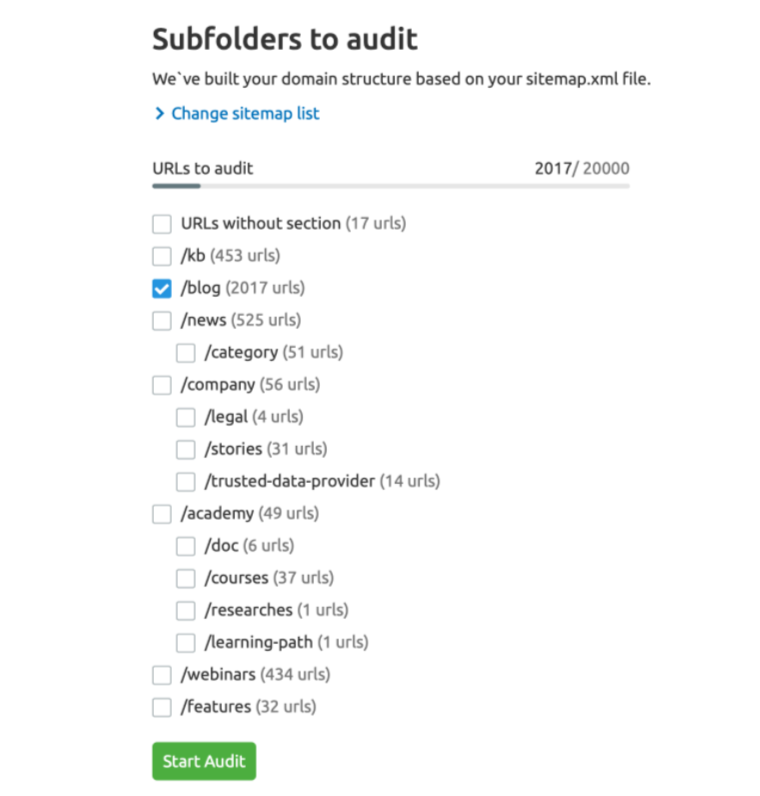How to Use SEMrush for Developing a Brilliant Content Strategy

10 Min Read
Content Marketing is not just about creating and publishing content. It is about developing a more strategic approach to attract and engage with well-defined audiences with the ultimate goal of generating profitable leads and conversions.
In this post, we are going to cover every aspect of developing a content marketing strategy. Let’s look at the core framework of preparing a strategy. The best third-party tool you can use for insights on your existing content performance and planning for long-term goals is SEMrush. Of course, Google Analytics and Google Search Console are the first set of tools you must check, and the best way to make use of all these tools is to integrate them into SEMrush to get a beast dashboard equipped with every information you need.
The Elemental Framework of Preparing a Content Marketing Strategy
Brand Positioning
Brand Positioning helps you deliver a consistent experience for your audience and build your own unique brand image across all channels.
Doubtful about your position in the marketplace? Get right into brainstorming with some of the questions below:
– Who are my potential customers?
– What solutions are they looking out for in the marketplace?
– What is the competitive outlook? How tough is it?
– Who are the top competitors?
– What is my brand’s unique selling proposition? What value points am I providing them?
– What pain points of my customers can I solve?
– How is my brand a better choice than my competitors?
– What dignifies my brand personality?
Unique Media Value Proposition
How can you distinguish your brand other than producing authentic and quality content? You need to define your media value proposition. Is your content credible and trustworthy? What encourages your followers to read your content? How are you different from the rest of the content creators?
Begin by performing a detailed analysis of your target audience, the type of content they are looking for, and their go-to resources. Post that, dive into your competitor’s content strategies and performance to get a better understanding of your position.
More importantly, you need to understand that your market rivals could be different from your content creator rivals. Once you decide to curate your unique identity, you need to consider every booming content creator in your industry. Ensure that you include every form of content publishers like online magazines, industry blogs or influencer’s belonging to your area of expertise. All of these tasks form a part of your competitive research for content.
Business Goals
This is pretty much not a novel piece of information for you, but from a content marketing perspective, this needs to be done appropriately. In addition to engaging new readers and followers, you need to aim mainly at providing value to your audience.
This needs brainstorming too. Post you jot down your goals precisely, you need to develop a business case that helps you understand the reasoning behind initiating the project. You would get an idea of the benefits, costs, risks, timescales of implementing a strategy thereby assuring your decision-makers of its value for the company.
Calculated Plan
Now, comes the important part. A strategic plan must aim at the business goals and the exact detailed path you would undertake to achieve them. It would be a well-developed plan that will help you decide the outcome of your content marketing efforts, more elaborately – the reach of your content marketing, the method of delivery, the measurement of its results.
Now, let us look at a detailed step-by-step process on how to go about developing a strategy.
Steps to Create a Comprehensive Content Blueprint
Step 1: Auditing Content Already present on your website
There are more than 70 million new posts published every month as per WordPress data, and more than 400 million people viewing content every month. There is a gigantic amount of information existing on the internet for your audience to click on, and you need to stand apart by having interesting and interactive content which caters to the audience for their informational needs.
You need to start off by developing an inventory of all your URLs and metrics. SEMrush’s Content Audit Tool is the best way to go about it. You can audit the content on your website by entering in a sitemap.xml file and checking your domain structure. If your site doesn’t have a sitemap, use a sitemap generating tool to build one. Some of the best ones include Slickplan, Dynomapper, Mindnode, etc.

After compiling all URLs, the next step is to sort them by different criteria. You can categorize in any way that is suitable to your website like content type(blog post, manual, landing page), content format(text only, images, etc.), number of words, authors, etc.
Also, collect the title and metadata for every piece of content you own so that it would be very easy for you to revise and update them all in one place.
You can also connect your Google Analytics and Google Search Console accounts of your website to give more depth to your data in SEMrush. Additional metrics such as average session duration, page views, bounce rate, search queries can be insightful for the audit.
Next, you can rewrite/remove, update, have a quick review, identify poor content through the Content Audit tool and take the necessary steps accordingly.

By performing the above activities you will be able to learn the actual condition of your content. Which form/type of content is the best performing content? What is the scope of improvement?
Step 2: Define your Business Goals
You need to be very specific about setting your goals and objectives. More importantly, you need to ensure that each piece of content you’re publishing is built towards meeting those goals. You can categorize your goals into long-term and short-term. The long-term goals can contribute to the overall mission you wish to achieve and the short-term goals can mainly take care of the specific operational goals in your plan.
Here are a few tips to spruce up your KPI’s:
– Lay down your goals as a challenge
– Measure them with an improvement indicator on a scale of 0 to 100%
– Adjust and assess the goals according to the new condition. There are chances that it might become irrelevant.
In contrast to standard KPIs, involving these while goal setting allows you to become more flexible and update it to the current working scenario.
Step 3: Learn and Ascertain your target audience
This is time-consuming and needs to be conducted thoroughly to deliver the best experiences. You will have to learn about their lifestyle, their concerns, problems, and requirements.
Firstly, you need to understand a distinguishing fact that your target audience aren’t just buyers. They are the first set of people that make an interaction with your brand, become aware, and start following you long before they decide to buy your product and become brand advocates.
Before they become your customers you need to convince them via your content that you are worth their investment. To understand more deeply about your audience, try finding out answers to the following:
– What demographics does your prospective audience belong to?
These include gender, age, location and other solid pieces of information.
– What personality traits do they have?
Are they lazy, productive, optimistic, or have other traits that can be detected with respect to their shopping habits?
– What is their motivation factor?
Do they want to learn more about your products or are they just window shopping on your website? Learning this allows you to personalize the content accordingly.
– What are their pain points?
If you know this, you can offer an ideal solution that would via your content. This would answer all their queries regarding the product and how it would help in solving their pain.
– What are their preferred content channels?
Knowing their preferences with respect to the websites they visit, social media they follow and the apps they use can be very helpful in offering the best experiences.
Another idea that works great for understanding your audience/prospects is to put yourself in their shoes. Try to identify the task that your prospect is trying to get done and what forms of obstacles are they facing.
A very simple example goes something like this: your prospect spends too much time completing all the tasks, and that’s why he/she is looking for a time management tool.
Once you deeply understand your prospect’s current problem, you can prepare compelling content revolving around the solution you offer that would convert them into buyers and brand advocates.
Step 4: Establish a Content Plan
Now, the core steps of the strategy begin ie. planning your content. It helps in allocating your resources efficiently and ensures a smooth workflow.
Firstly, jot the actions/tasks that need to be done and prioritize the most critical ones that need to be done on first preference. By doing this, you can save your strategy from failing and find room for experiments.
Next is to find the appropriate topics that have absolute potential in attracting your audience. The Content Marketing tool of SEMrush is fully equipped with that. Head to the Topic Research tool – it gives you ideas on the subjects you would like to cover. Just type in the topic you want ideas for and the country you would like to target. It gives you suggestions based on what most people are searching for. Also, related questions, subtopics, headlines are an added advantage in finding exactly what your audience is searching for.

Once you have determined the topic and the headline to include in your content, the next step is to organize your tasks. You can make the best use of the Marketing Calendar tool on SEMrush for this, where you can add in tasks, monitor the progress, set deadlines, and also cross-communicate with your team members with respect to creating, editing, and publishing content.
Step 5: Strategize Content Creation & Development
The next categorical step is planning your creation and production. But what are the areas of concern that you need to keep in mind while creating? Here you go…
Ensure it covers every part of the consumer journey
The ultimate long-term goal is to build a long-term relationship between your brand and your customers. Make sure your content supports every prospect of the consumer funnel with interactive engaging pieces.
Cover all content types
Long gone are the traditional advertisement-based blog posts or plain infographics that yesteryear agencies used to implement in their strategy. Content is diversified now, with more preference for visual content, so make sure you include a good mix to appeal to every prospect.
Ensure every piece is SEO friendly
This is very important to increase visibility on organic search results. The SEO writing assistant on SEMrush is very useful to optimize any piece of content. It is available as a WordPress plugin and googles Docs add-on. Or you can simply put it in the tool and get suggestions for improvement.
Repurpose Your Existing Content
Once new content is published, you can appeal to new readers by repurposing it into interesting forms like articles into infographics or slide presentations, also informative images on social media.
Focus on User Generated Content
Include User-generated content on your website that would help you grow your reputation as well. The Brand Monitoring tool by SEMrush gives you insights on the mentions of your brand so that you can get an idea of how well your content is performing. You can also compare it with competitors’ information.
Step 6: Strategize on Content Distribution
Once you have planned on the production, it’s time to plan on the distribution. Here are some pointers that you need to consider.
Identify your most Suitable Channel
Try to find where your audience spends most of their time on social media and which could be the best source for your content to be seen other than your business website. It could be Facebook, Pinterest, Instagram, and many more. You can use your target demographics and determine your most relevant channel. Like Facebook has more of a millennial and boomer audience and Snapchat has more of a Generation X audience.
Develop an Omnichannel Experience
By forming an experience that is suitable for every channel you’re publishing, you’re creating the best content. Align your brand message and content across every channel, so that your audience can get a clear understanding of what you have to offer.
Step 7: Examine your results with the help of metrics
This is the final and deciding step of your strategy preparation. Analyzing your content performance gives you a better understanding of what type of content is clicking with your audience and what interests them the most. Knowing this will help you formulate new and more target-specific content for them.
SEMrush via its content audit tool and the Post tracking tool lets you view your performance in content using various popular metrics. Here’s what you can do with these tools:
– Measure your performance by stages
– Find out the impact of your content upon conversion
– What content is your audience drawn to
– How to boost performance on the under-performing content pieces.
What are the essential metrics to measure your content performance?
User Behaviour
These include unique pageviews, visitors, new and returning users, average time one spends on the page, bounce rate, traffic sources, etc. You can access all this information via the Content Audit tool or your Google analytics.
Engagement
This indicates its popularity among your audience. They include Likes, Shares, comments, mentions, republications, etc. You can get hold of all these in SEMrush’s Post Tracking, Brand Monitoring, and Social Media Tracking tool.
SEO results
This includes everything related to SEO such as organic traffic, backlinks, keywords, which again you can opt for Google analytics or SEMrush for insights.
Company earnings
This includes measuring the returns of the core investment for this project like the number of leads, conversion rate, number of existing leads that interacted with your brand, etc.
Final Thoughts
The techniques for developing a content marketing strategy may change over time, but the core principle essentially remains the same – sorting out a plan based on authoritative, trustworthy data.
We are Experts in Content Marketing!
Indian marketers have worked with top-notch clients and can serve you for your content marketing needs as well. Avail our Content Marketing Services today!
Recommended Posts

How does local SEO help your website rank better on Google?
March 11, 2022

Why Your Website not visible on Google? Find out
March 7, 2022

